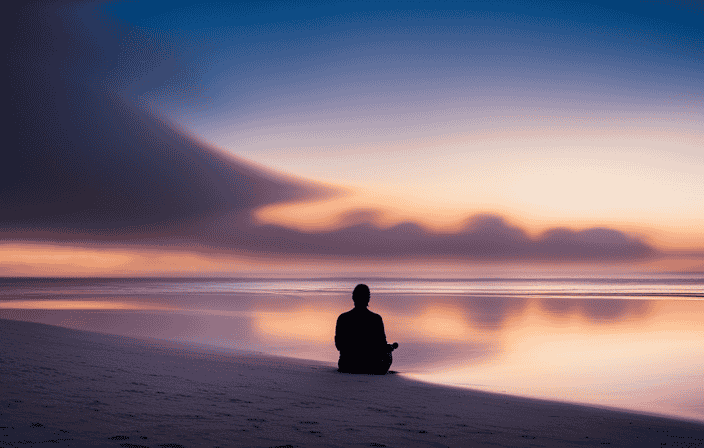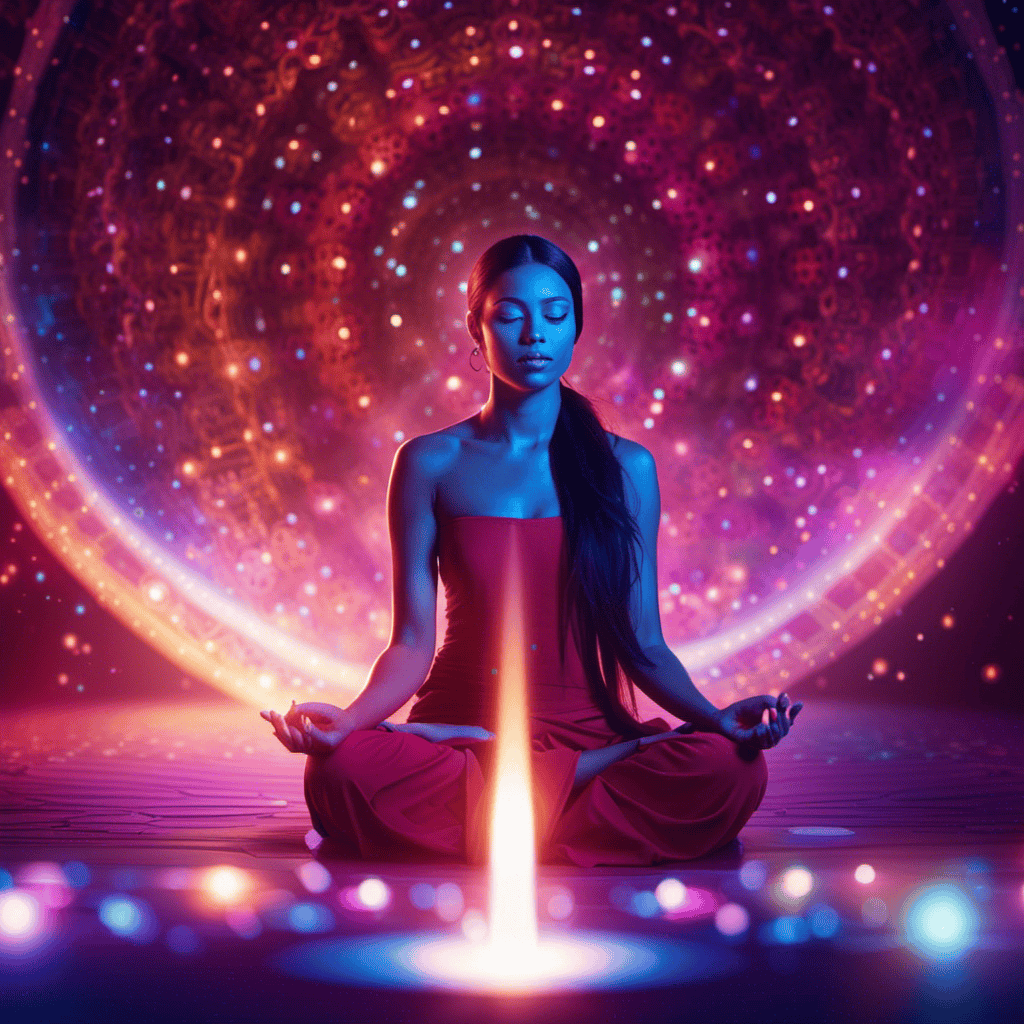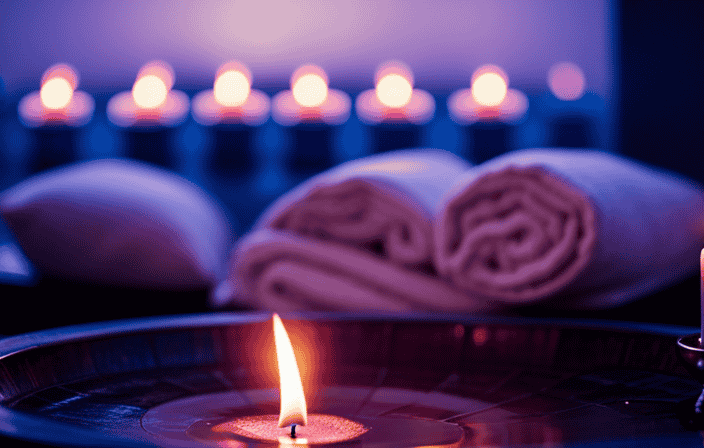In the realm of meditation, the hands serve as the conductor’s baton, directing the orchestra of the mind. They possess the ability to elevate our meditation experience, fostering a heightened level of concentration and vitality.
Just as different hand positions in dance communicate different meanings, so too do they in meditation. From the sacred Lotus Position to the humble Seated Forward Bend, each position carries its own significance and purpose.
Join me on a journey of exploration as we delve into the world of meditation hand positions and discover how they can elevate our practice.
Key Takeaways
- There are different hand positions in meditation that can enhance energy flow and focus the mind.
- Lotus and Half Lotus positions are recommended for beginners as they calm and anchor energy and attention, and open energy pathways.
- Meditation Cloak and Meditation Bow hand positions create a sense of protection and security, and openness and receptivity, respectively.
- Burmese Position and Seated Forward Bend hand positions create a sense of energy and movement, and stretch and relax the body.
Hand Positions: Basics
I find it helpful to understand the basics of hand positions in meditation, as they can enhance my practice and help me achieve a deeper state of awareness.
Hand positions, also known as mudras, are specific gestures or positions that we hold with our hands during meditation. These hand positions are believed to enhance energy flow and focus the mind. They have different meanings and purposes, creating physical, mental, and spiritual effects.
As a beginner, it is recommended to start with basic hand positions such as the Lotus Position, where the palms touch and the fingers are slightly apart. Another option is the Half Lotus Position, where the left thumb touches the base of the right index finger and the other fingers curl into a fist.
By experimenting with these hand positions, I can find what works best for me and enhance my meditation experience.
Lotus and Half Lotus
The Lotus and Half Lotus positions are hand positions commonly used in meditation. In these positions, the palms are touching with the fingers slightly apart, while the thumbs are pressed together. This hand position creates a calming effect and helps to anchor energy and attention during meditation.
The Lotus position is known for its ability to enhance spiritual openness, while the Half Lotus position opens up energy pathways in the body. These hand positions can be experimented with to find what works best for each individual’s practice.
They are recommended for beginners as they provide a foundation for a focused and centered meditation practice. By using the Lotus and Half Lotus positions, one can enhance their meditation experience and achieve a deeper state of awareness.
Meditation Cloak and Bow
The Meditation Cloak and Bow create a sense of protection and openness, respectively, when the left hand is placed on top of the right hand, with the thumbs wrapped around each other in a circle. The Meditation Cloak position is achieved by having the palms facing up, while the Meditation Bow position involves the palms facing up with a gentle pull apart. These hand positions offer different experiences and serve different purposes in meditation. The Cloak position creates a sense of security and grounding, while the Bow position fosters receptiveness and openness. To further illustrate the differences between the two hand positions, I have created a table:
| Hand Position | Purpose |
|---|---|
| Meditation Cloak | Creates a sense of protection |
| Meditation Bow | Fosters openness and receptivity |
Experimenting with different hand positions can enhance your meditation practice, allowing you to find what works best for you and helps you achieve a deeper state of awareness.
Burmese and Seated Forward Bend
Burmese Position and Seated Forward Bend offer different physical benefits and sensations during meditation. Here’s what I’ve learned about these two hand positions:
-
Burmese Position: Placing my right hand on top of my left with palms facing up and thumbs wrapped around each other creates a sense of energy and movement in my body. I feel a heightened awareness and increased focus when I hold this position.
-
Seated Forward Bend: Sitting with my legs straight and bending forward from the waist, reaching for my toes or grabbing my ankles/shins, stretches my spine and relaxes my back and neck muscles. This position helps release tension and promotes a sense of calmness in my mind and body.
Both of these hand positions have their own unique benefits and sensations. I find it helpful to alternate between them during my meditation practice to enhance my overall experience.
Standing Posture
Standing in a grounded posture with my feet hip-width apart allows me to focus my energy and maintain stability during meditation. This standing meditation posture helps me feel connected to the earth and creates a strong foundation for my practice. By tucking in my chin, keeping my back straight, and relaxing my shoulders, I am able to align my body and encourage a sense of balance and calm.
This hand position grounds and centers my energy, enabling me to cultivate a deeper state of awareness. Holding this position for 5-10 seconds, I can feel the energy flowing through my body and my mind becoming more focused.
While hand positions are not necessary for successful meditation, using the standing posture enhances my experience and helps me achieve a greater sense of presence and mindfulness.
Duration of Holding Positions
During my meditation, I find it beneficial to hold each position for 5-10 seconds to fully experience its effects. Holding the hand positions for this duration allows me to fully engage with the energy and intention of each posture. It gives me enough time to ground myself and focus my attention before moving on to the next position.
This duration also allows me to observe any physical, mental, or spiritual effects that arise during the practice. By holding each position for a short period, I can explore the sensations and benefits they provide without feeling rushed.
It’s important to note that the duration of holding hand positions may vary depending on individual preference and practice. Experimenting with different durations can help you find what works best for you and enhances your overall meditation experience.
Importance of Hand Positions
When exploring different techniques for meditation, it’s important to understand the significance of hand positions and how they can contribute to a deeper state of awareness.
Hand positions, also known as mudras, have been used for centuries to enhance the meditation practice. They can play a role in focusing the mind, enhancing energy flow, and creating physical, mental, and spiritual effects.
However, it’s important to note that hand positions are not necessary for successful meditation. Each individual may have different preferences and goals when it comes to their meditation practice.
Experimenting with different hand positions can help you find what works best for you and what helps you achieve a deeper state of awareness. Whether you choose to use hand positions or other techniques, the goal is to find what enhances your experience and allows you to connect with yourself on a deeper level.
Experiment and Explore
Now that we understand the importance of hand positions in meditation, let’s dive deeper into the topic and explore the idea of experimentation and exploration.
As an individual practitioner, it is crucial to experiment with different hand positions to find what works best for you. Every person is unique, and what may work for someone else may not necessarily work for you. By exploring various hand positions, you can discover the ones that enhance your practice and help you achieve a deeper state of awareness.
Remember, there is no right or wrong hand position in meditation. The key is to find what feels comfortable and allows you to focus your energy and attention. So, embrace the journey of experimentation and explore the vast possibilities that meditation hand positions offer.
Frequently Asked Questions
How do hand positions in meditation affect energy flow and focus?
Hand positions in meditation affect energy flow and focus by enhancing the connection between the body and mind. Different hand positions have specific meanings and purposes, creating physical, mental, and spiritual effects to help achieve a deeper state of awareness. Experimentation is key to finding what works best for you.
Are there any specific hand positions that are recommended for beginners?
For beginners, I recommend trying the Lotus Position or Half Lotus Position. In the Lotus Position, you touch your palms together with fingers slightly apart, while in the Half Lotus Position, your left thumb touches the base of your right index finger.
What are some alternative hand positions that can be used in meditation?
Some alternative hand positions in meditation include the prayer position, where the palms are pressed together in front of the chest, and the Gyan mudra, where the index finger and thumb touch. These positions can help enhance focus and energy flow during meditation.
Is it necessary to hold hand positions for a certain duration of time in order to benefit from them?
No, it is not necessary to hold hand positions for a specific duration in order to benefit from them. The duration can vary depending on your practice and personal preference. Experiment and find what works best for you.
Can hand positions in meditation enhance spiritual openness and receptivity?
Hand positions in meditation can indeed enhance spiritual openness and receptivity. By using specific hand positions, such as the Half Lotus or Meditation Bow, we can activate energy pathways and create a sense of openness and receptivity, allowing for a deeper spiritual experience.









